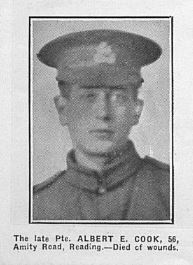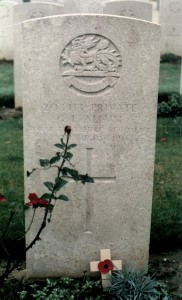Henry Thomas Eighteen
Private 20350
1st/4th Royal Berkshire Regiment
At the time of the death of Henry Eighteen on 24 November 1916 the 1st/4th Battalion was serving on the Somme in the area of the Butte de Warlencourt. The Butte was an ancient burial mound some fifty feet high held by the Germans. In the gently undulating fields of the Somme it gave the occupying force not only an observational advantage but also a strong point of defence. The Butte was part of the last line before Bapaume. The Germans had the visual advantage in an area where the British trenches were dangerous with gaps in their defence. Conditions for the Berkshire men were dreadful and it was common for the 1st/4th to suffer six or seven casualties each day for the period they occupied these trenches.
s death refers to him having been killed in action in Albert. The Butte de Warlencourt is on the Albert to Bapaume Road about 10 miles from Albert.
Private Eighteen is buried in Adanac Military Cemetery, Miraumont, Somme.
This cemetery is a concentration cemetery. It was made after the Armistice by the concentration of graves from the battlefields and small cemeteries surrounding Miraumont, and particularly the Canadian battlefields around Courcelette. The cemetery name comes from reversing the name Canada and the maple leaf is much in evidence. It was fortunate that Henry’s original grave was well marked and that it was not lost during later battles, as often happened.
Henry’s story illustrates how information must be gleaned from several sources in order to give a complete picture. In his case the local newspapers have been particularly valuable. Henry Thomas Eighteen is now known to be one of the five sons of Mr Frederick Syer Eighteen and Mrs Charlotte Ellen Louisa Eighteen (nee Smith) of 30, Leopold Rd., Reading. Work done on the Eighteen family tree available throught Ancestry UK indicates that there were 12 children. The 1911 census indicates that Frederick senior was a fish salesman, sons Stanley and John were both helping in the business and the rest of the children, including Henry Thomas were in school.
The Reading Chronicle 31 August 1917 gave notification of the wounding in the eye of Stanley James Eighteen on 18 August; he had been in service 18 months and had spent 14 months in France. This notice indicated that there had been five sons serving in the army, two had been killed, two wounded and one was still serving. From another report came information about John Bernard Eighteen, Driver 10213 ‘D’ Battery 75th Brigade Royal Field Artillery. It is now known that he was Henry’s older brother. John Eighteen died of wounds and is buried at Wimereux Cemetery. Wimereux was the site of many base hospitals. At the time of his death on 25 June 1917 John was aged 21. Stanley James was an older brother to both Henry and John and he survived the war living until 1956.
Both Henry and John Eighteen are commemorated on the memorial of the Trinity Congregational Church, Reading. On the second anniversary of Henry’s death another ‘In Memoriam’ was published in The Reading Chronicle, 22 November 1918. It was particularly poignant because the Armistice had just taken place and people were looking forward to loved ones returning, it should be noted that in this document the father appears to be a widower:
Eighteen – In ever loving memory of Henry Thomas killed in action November 24th 1916.
He left his home in the flower of youth, he looked so strong and brave,
We little knew how soon he was to be laid in a soldier’s grave;
But the hardest part has yet to come, when the heroes all come home,
And we miss among the cheering crowd one that will never return.
From his loving father, sisters and brothers.
The name Eighteen is not particularly common, only three soldiers of that name appear in Soldiers Died although it was a well known name in Reading. The impact of the war is illustrated by another entry in The Reading Chronicle September 1915 when it was reported that H. Eighteen, Horse dealer of Reading, had sold his business when both his son and nephew enlisted.


